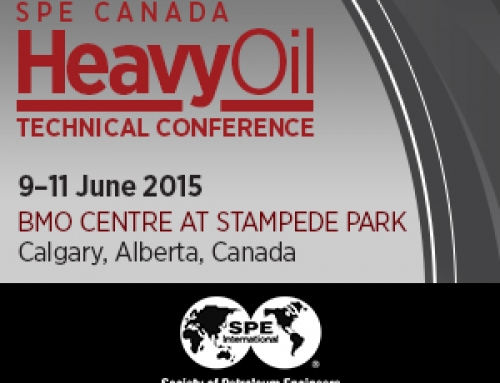| (Calgary, AB) – June 16, 2015 – PERM Inc. President & CEO, Dr. Apostolos Kantzas is featured in a video presentation from 2014 on the Grosmont Carbonates in Alberta and the results (production and SOR) achieved.
A few quotes from the presentation:
The presentation I am going to give you today is work we have done over the last six years and tries to present anonymously work that we have done for different parts of the Grosmont Carbonate.
It’s four zones: A, B, C, D – going from A at the bottom and rising to D. C & D are the ones that most people are talking about. There is a very thin zone between C & D that some of you call it the “Marl”, others we call it the “Dolofudge”.
When it comes to thermal recovery of bitumen we have looked at a number of different mechanisms, they are fairly standard. Primarily we are heating the bitumen to reduce the viscosity. As we are heating, fluids are expanding, because of expansion there are fluids that come into production. We have alteration of the rock properties. We have in-situ gas generation. We have some solution gas drive. But primarily we are dealing with gravity drainage, or so we think. We also, when it comes to these carbonates, we are looking at some flashing of water that pushes oil out of permeable pathways. And finally, when steam condenses and becomes water, we have preferential invasion of water into the tighter matrix, which we call imbibition. That imbibition can also give us some incremental oil.
The Marl in between, people consider it impermeable and others consider it permeable. It has been proven that there is communication between C & D.
We have been given full wells or we have been given pieces of core, and we were able to scan it at very high frequencies. As such, we were able to generate very detailed heterogeneity porosity maps of the Grosmont Carbonates for variable areas.
There is a lot of heterogeneity also in the viscosity of the oil… (when comparing against typical Athabasca Bitumen): Oil that we have extracted from different cores from different parts of the reservoir, some of them fall close, most of them are heavier, significantly heavier.
We have run a lot of magnetic resonance. The magnetic resonance allows us to look at the distribution of fluids within the rock.
What we call Grosmont Bitumen, we do not consider it as a single fluid because of this variability of viscosity and there is a corresponding variability on API. It’s two full units of API actually that we have seen difference. Having said all that, Laricina has published pictures that they drilled the well and bitumen was actually floating through the drilling tool and coming out by its own strength, which implies that there was something to help it move there.
We run several types of tests. One type of test, we call it the soaking test. This is the simplest possible test you can run. Just stick the core into a coreholder without overburden and you allow either hot water or steam to wash the core from the outside… The recovery factors were as low as 15% in one of the most unfortunate cases, and as high as 41% of the oil in place when were just doing this washing; there is no drive… The very first part that appears to be quite fast is what we attribute to thermal expansion. We also attribute that, depending on the temperature that we run, if we reach the boiling part of the connate water, then the connate water expands and so you have, like a little detonation, and that pushes some oil out and then the water condenses because the pressure in there has been reduced, so the drive is lost, and then everything else is the contribution of the drainage or the imbibition component.
The core that apparently had the highest porosity, gave us the lowest recovery… (when talking about “open porosity”): A conclusion we can draw right here, it’s not the porosity itself that does the damage, it’s the distribution of the porosity that we need to map if we are going to predict what the recovery factors are going to be.
The next set of tests dealt with direct floods… In general, either you work with hot water just under the saturation point or you work with super heated steam, and you may want to switch from water to steam or steam to water as part of your flood… We were able to bring the residual oil to below 40% sometimes.
(while talking about hot water flooding): The recovery of steam was always lower than the recovery of water… We attribute that to water imbibing into the matrix and displacing additional oil. Whether the water is allowed to imbibe because the connate water had already flashed and there is a space available, or more likely because there is wettability alteration towards more water-wet conditions, it’s still debatable. We have run wettability experiments… that indicated to us that more water gets into the matrix of the carbonate rock as the temperature goes up above 150°C.
A lot of gas is generated during these experiments. Much, much larger amounts than you would consider because of solution gas. So this gas is chemically generated and I would be very happy to be call it aquathermolysis gas but it starts immediately and it starts at temperatures as low as 150°C, which is below aquathermolysis conventional startup. The gas is primarily CO2. We see some traces of methane… We see hydrogen. We did not see carbon monoxide. Every time we see increase in hydrogen, we see decrease in CO2, and vice-versa. We are convinced there is a reaction that takes place, and over and above the expected aquathermolysis, we have a geochemical reaction taking place… For the volumes of gas that we generate in the lab, we don’t have a SAGD type of environment anymore, we have a SAGP steam and gas pushed type of environment.
RF of dry steam: 15-40% OOIP
RF of wet steam/water 50-75% OOIP
To inject solvent at reservoir temperature is a non-starter. We will have to somehow heat the reservoir… You guys heard about the “ESEIEH” process… They can heat electromagnetically the formation and inject the solvent.
(solvent): In order for this to work, the choice of final reservoir temperature is critical… That optimal temperature is, depending on the system, depending on the solvent, for propane it looks like it will be less than 80°C…
Soaking experiment with solvent present… We had a company that wanted to inject propane at 200°C. We tried to do that, we run it at 200°C, we didn’t acquire a single drop of oil after steam… We do it again, exactly the same numbers… We started dropping the temperature to what we were expecting to see… low and behold when we started coming down to the temperatures below 80°C, we started seeing oil coming out and it was coming out in oodles. The ultimate recovery factor to that was 65%, while after the steam soak it was only about 15%. So I’m not saying that solvents will work because you have to recover the solvent and good luck with that, right? But if you were to inject the solvent, its the optimum temperature selection for the solvent that you need to worry about. Then how you are actually going to heat the reservoir to the optimum temperature and leave it there.
When we did the full well CT scanning we able to actually analyze the geology of the formation in a great degree, get detailed porosity maps, we were able to separate primary versus secondary porosity, the extent of that distribution within different zones in the formation and then you classify each zone by its porosity variability… What we are working on now is by taking those images to reconstruct the permeability map of these different zones.
We are looking at measurements of thermal conductivity and how to measure the thermal conductivity of full diameter core under various saturation and then feed that as a function of temperature for different simulations. And because of the EM heating interest, measure the di-electric properties of a partially saturated full diameter core as a function of temperature.
From the production monitoring point of view, we had the Saleski pilot as the first commercial application of our multi-phase magnetic resonance based metering device, and it’s actually closing to its third year of operation.
(regarding the Grosmont Carbonates): I have some conclusions… it’s not homogeneous. Just because somebody got a number doesn’t mean you will get the same number.
The thing that people are not paying attention to… is the issue of gas generation; there is a lot of gas being generated. If we are to make relative permeability predictions from our corefloods, it’s impossible because we have a three phase system.
We have seen this type of gas generation in both sands and carbonates. The sands that have more clay, more dolomitic cement, generate a lot more gas than the pure sand. So if you take a sand, you wash it with hydrochloric acid, pack it, saturate with water, heat it up to temperature, you won’t see gas. So the more clay, the more carbonate material in the sand, the more gas will come out. When it comes to carbonates, gas will come out in oodles, irrespective. It has to do with the carbonate rock as a first pass… the pressure affects the kinetics… A secondary reaction that is more prevalent in the sands is clay transformation… generates CO2… The fact that it is hundreds of times larger than any GOR eliminates the possibility that it is GOR driven. If you calculate a GOR equivalent of 300, it can’t be. The other thing that makes it separate from aquathermolysis, in many cases we didn’t have H2S generation, in the cases with H2S, it was very small.
Please get in touch by emailing us at [email protected] or sending a message on our contact page.
|





